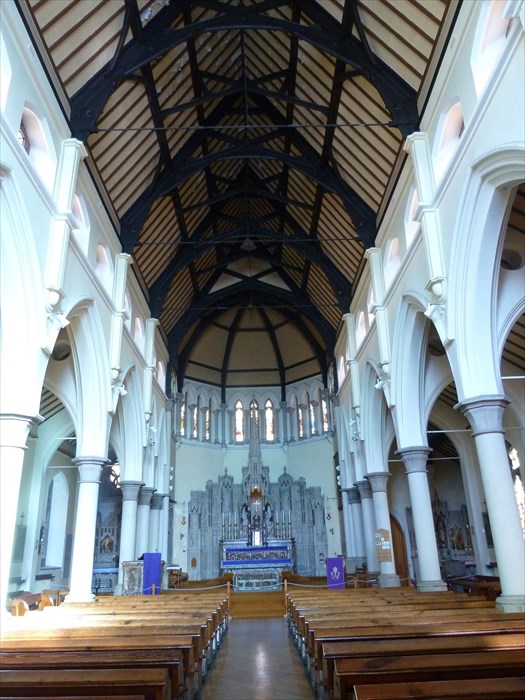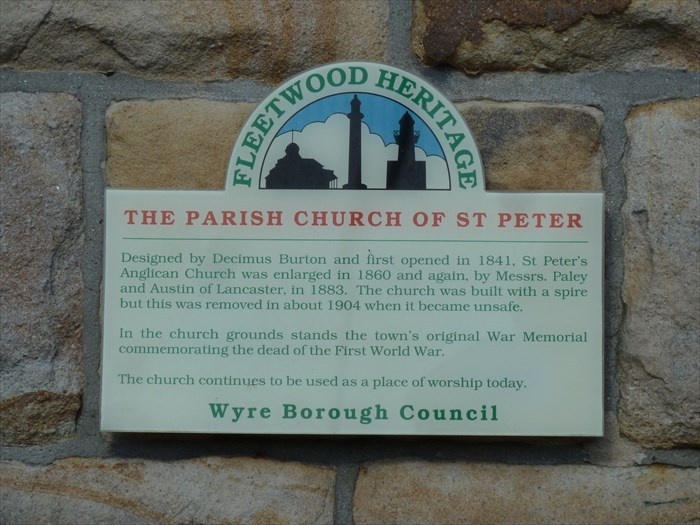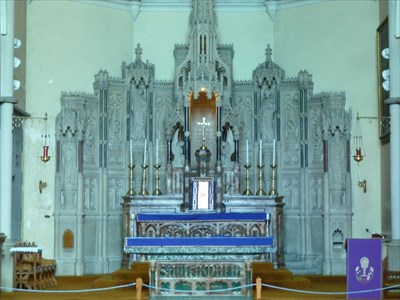
Parish Church of St. Peter - Fleetwood, UK
Posted by:  silverquill
silverquill
N 53° 55.418 W 003° 00.568
30U E 499378 N 5975025
This may have been the first church built in Fleetwood, designed by Decimus Burton who laid out the design for this planned town and then designed many of the buildings. This church was dedicated in 1841.
Waymark Code: WMJTM8
Location: North West England, United Kingdom
Date Posted: 12/30/2013
Views: 3

St. Peter's is one of the landmark buildings in Fleetwood, a seaside town that was once the third largest fishing port in England. When Peter Hesketh-Fleetwood hired Decimus Burton to undertake the master plan for a new town at the mouth of the River Wyre in 1836, this church took a central place and construction was begun in 1839, and Peter Hesketh-Fleetwood himself laid the foundation stone.

THE PARISH CHURCH OF ST PETER
Designed by Decimus Burton and first opened in 1841, St. Peter's
Anglican Church was enlarged in 1860 and again by Messrs. Paley
and Austin Lancaster in 1883. The church was built with a spire
but this was removed in about 1904 when it became unsafe.
In the church grounds stands the town's original War Memorial
commemorating the dead of the First World War.
The church continues to be used as a place of worship today.
Wyre Borough Council
In 1978 it received the Grade II designation on the English Heritage Listed Buildings. The following is an excerpt from the official listing:
GV II Parish church of 1839-41 by D. Burton, extended in 1883 by Paley & Austin.
MATERIALS: Coursed and dressed sandstone, rock-faced to nave and tower, with freestone dressings, slate roofs.
PLAN: Nave with west tower, transepts, chancel with separately roofed north organ chamber and south chapel.
EXTERIOR: The broad nave and the tower are in the simple Gothic style of the early C19. The 2-stage squat tower (designed to carry a spire that has been removed) has diagonal buttresses in the lower stage with gabled offsets, polygonal buttresses in the upper stage carried up as corner polygonal turrets in the corbelled and embattled crown. Entrances are in north and south walls. The west window is triple pointed lights. In the narrower bell stage are paired openings with louvres and linked hood moulds. The buttressed nave is divided into 5 narrow bays by gabled buttresses, built against pilaster strips, and corbel table. It has tall pointed windows and sill band. The eastern end is in a more developed Early-English style, with steeper roofs than the earlier work. Transepts have triple stepped windows with shafts (the north window blocked) and shallow lean-to west porches. East windows are varied although they are all of the same date. The chancel east window is 5 lights, the central taller, and with tracery circles above the outer pairs of main lights. In the south chapel the east wall has 4 blind arches on shafts, 2 enclosing small quatrefoil windows, and with 4 lights to the south window. The organ chamber has an east window of 2 lights with hood mould.
HISTORY: Built in 1839-41 by Decimus Burton as an integral component of the new town of Fleetwood, laid out by Burton for Sir Peter Hesketh-Fleetwood (1836-43). Burton (1800-81) was the son of a London builder, began his career in 1821 and retired in 1869. His architecture was essentially undogmatic and scenic, which is not to say that it could not be tough-minded when necessary. He is particularly associated with urban planning, having assisted his father in the design of terraces at Regent's Park and at St Leonards, East Sussex. His major works in this genre is the Calverley Estate in Tunbridge Wells (1828 onwards). Although best known for work in Greek Revival style, all his small number of churches are in plan gothic styles, of which St Peter's is not unrepresentative. At Fleetwood, a scheme only partly completed, he also designed the North Euston Hotel, Queen's terrace, the Custom House and two lighthouses. The east end of the church was extended in 1883 by Paley and Austin, architects of Lancaster, who added the present transepts, chancel, vestry and chapel. The spire was removed in 1904.

The organ, of 1924, is by James Binns of Leeds and incorporates the Binns patent tubular pneumatic action (From:
English Heritage Listed Buildings
The Te Deum east and other early C20 windows are by Ward & Hughes, and the south transept window of St Peter is by R.B. Edmundson & Son (1860) From: English Heritage Listed Buildings
Visit Instructions:1) A photo of the church is required for visits to a waymark.
2) Please share some comments about your visit.
3) Additional photos are encouraged. If you can have information in addition to that already provided about this church, please share it with us.